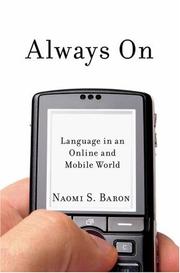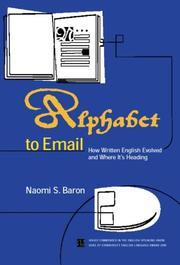| Listing 1 - 10 of 15 | << page >> |
Sort by
|
Book
ISBN: 0444850775 Year: 1977 Volume: 36 Publisher: Amsterdam North-Holland
Abstract | Keywords | Export | Availability | Bookmark
 Loading...
Loading...Choose an application
- Reference Manager
- EndNote
- RefWorks (Direct export to RefWorks)
Psycholinguistics --- Historical linguistics --- Children --- Linguistic change --- Enfants --- Changement linguistique --- Language --- Langage --- -Linguistic change --- Change, Linguistic --- Language change --- Language and languages --- Childhood --- Kids (Children) --- Pedology (Child study) --- Youngsters --- Age groups --- Families --- Life cycle, Human --- Linguistic change. --- Language. --- Language development in children --- Interpersonal communication in children --- Vocabulary

ISBN: 9780195313055 0195313054 0199735441 0199871094 9786611341992 0198042701 1281341991 9786612501081 019974131X 1282501089 Year: 2008 Publisher: Oxford Oxford university press
Abstract | Keywords | Export | Availability | Bookmark
 Loading...
Loading...Choose an application
- Reference Manager
- EndNote
- RefWorks (Direct export to RefWorks)
Linguistics --- Mass communications --- Language and languages. --- Instant messaging. --- Internet. --- #SBIB:309H514 --- #SBIB:309H518 --- IM (Instant messaging) --- Messaging, Instant --- Data transmission systems --- Microblogs --- Foreign languages --- Languages --- Anthropology --- Communication --- Ethnology --- Information theory --- Meaning (Psychology) --- Philology --- DARPA Internet --- Internet (Computer network) --- Wide area networks (Computer networks) --- World Wide Web --- Linguistiek --- Verbale communicatie: sociologie, antropologie, sociolinguistiek --- Instant messaging --- Internet --- Language and languages

ISBN: 0415186862 0415186854 0203272277 0203194314 1134663080 1280326646 1134663072 9780415186858 Year: 2000 Publisher: London ; New York : Routledge,
Abstract | Keywords | Export | Availability | Bookmark
 Loading...
Loading...Choose an application
- Reference Manager
- EndNote
- RefWorks (Direct export to RefWorks)
Alphabet to Email explores the ever-changing relationship between speech and writing and considers the implications of current language trends on the future of written English.
Anglais écrit --- geschreven Engels --- Anglais écrit --- Historical linguistics --- English language --- Written communication --- Written discourse --- Written language --- Communication --- Discourse analysis --- Language and languages --- Visual communication --- Germanic languages --- Written English --- History. --- Engelse taal --- geschiedenis. --- schriftelijke communicatie --- Anglais (Langue) --- Communication écrite --- History --- Histoire --- Stilistiek --- Historische taalkunde --- Pragmatiek --- Sociolinguïstiek --- Engelse taalkunde --- Stilistics --- Pragmatics --- Sociolinguistics --- Written communication - English-speaking countries --- English language - Written English
Book
ISBN: 9780199315772 0199315787 0199315779 1322411948 9781322411941 9780199315765 0199315760 9780199315789 Year: 2015 Publisher: New York [New York]
Abstract | Keywords | Export | Availability | Bookmark
 Loading...
Loading...Choose an application
- Reference Manager
- EndNote
- RefWorks (Direct export to RefWorks)
People have been reading on computer screens for several decades now, predating popularization of personal computers and widespread use of the internet. But it was the rise of eReaders and tablets that caused digital reading to explode. In 2007, Amazon introduced its first Kindle. Three years later, Apple debuted the iPad. Meanwhile, as mobile phone technology improved and smartphones proliferated, the phone became another vital reading platform.In Words Onscreen, Naomi Baron, an expert on language and technology, explores how technology is reshaping our understanding of what it means to read. Digital reading is increasingly popular. Reading onscreen has many virtues, including convenience, potential cost-savings, and the opportunity to bring free access to books and other written materials to people around the world. Yet, Baron argues, the virtues of eReading are matched with drawbacks. Users are easily distracted by other temptations on their devices, multitasking is rampant, and screens coax us to skim rather than read in-depth. What is more, if the way we read is changing, so is the way we write. In response to changing reading habits, many authors and publishers are producing shorter works and ones that don't require reflection or close reading.In her tour through the new world of eReading, Baron weights the value of reading physical print versus online text, including the question of what long-standing benefits of reading might be lost if we go overwhelmingly digital. She also probes how the internet is shifting reading from being a solitary experience to a social one, and the reasons why eReading has taken off in some countries, especially the United States and United Kingdom, but not others, like France and Japan. Reaching past the hype on both sides of the discussion, Baron draws upon her own cross-cultural studies to offer a clear-eyed and balanced analysis of the ways technology is affecting the ways we read today--and what the future might bring.
Reading --- Educational technology --- Tablet computers. --- Computer-assisted instruction. --- Interdisciplinary approach in education. --- Integrated curriculum --- Interdisciplinarity in education --- Interdisciplinary studies --- Curriculum planning --- Holistic education --- CAI (Computer-assisted instruction) --- Computer-aided instruction --- Computer-assisted learning --- Computer based instruction --- Computer-enhanced learning --- Electronic data processing in programmed instruction --- ILSs (Integrated learning systems) --- Integrated learning systems --- Microcomputer-aided instruction --- Microcomputer-assisted instruction --- Microcomputer-assisted learning --- Microcomputer-based instruction --- Teaching --- Education --- Programmed instruction --- Telematics --- Pad computers --- Slate computers --- Tablets (Computers) --- Laptop computers --- Instructional technology --- Technology in education --- Technology --- Educational innovations --- Instructional systems --- Language arts --- Elocution --- Technological innovations. --- Data processing --- Aids and devices --- Study and teaching --- Documentation and information --- Didactic strategies --- Tablet computers --- Computer-assisted instruction --- Interdisciplinary approach in education --- Technological innovations
Book
ISBN: 0253051207 Year: 1980 Publisher: Indiana University Press
Abstract | Keywords | Export | Availability | Bookmark
 Loading...
Loading...Choose an application
- Reference Manager
- EndNote
- RefWorks (Direct export to RefWorks)
Linguistics has traditionally dealt with questions about structure—what are the parts of a language and how are they assembled? Naomi Baron adopts a new approach by asking what a human language is used for and how it achieves its goals. She carefully examines what is communicated, why it is important. and how the exchange is accomplished. In the process of this basic redefinition, she fashions a lucid, systematic introduction to the study of linguistics. The initial chapters discuss language as a source and solution to problems of human communication, the various aspects of representation, the definition of human language, and a methodology for the functional analysis of language. The three chapters that follow fully explore this functional perspective for spoken, written, and signed languages, and offer new evidence to demonstrate the effect of social context on linguistic structure. Speech, Writing, and Sign is profusely illustrated with drawings, photographs, and reproductions of artistic examples. Written to be accessible to beginning students, this book will also interest linguistic scholars because of its challenges to current linguistic theory.
Language and languages. --- Functionalism (Linguistics) --- Foreign languages --- Languages --- Anthropology --- Communication --- Ethnology --- Information theory --- Meaning (Psychology) --- Philology --- Linguistics --- Functional analysis (Linguistics) --- Functional grammar --- Functional linguistics --- Functional-structural analysis (Linguistics) --- Grammar, Functional --- Grammatical functions --- Structural linguistics --- Literary theory
Book
ISBN: 9780190084097 9780190084127 9780190084110 0190084111 019008409X 019008412X 0190084103 Year: 2021 Publisher: New York : Oxford University Press,
Abstract | Keywords | Export | Availability | Bookmark
 Loading...
Loading...Choose an application
- Reference Manager
- EndNote
- RefWorks (Direct export to RefWorks)
"The digital revolution has transformed reading. Onscreen text, audiobooks, podcasts, and videos often replace print. We make these swaps for pleasure reading, but also in schools. How We Read Now is a ringside seat to the impact of reading medium on learning. Teachers, administrators, librarians, and policymakers need to make decisions about classroom materials. College students must weigh their options. And parents face choices for their children. Digital selections are often based on cost or convenience, not educational evidence. Current research offers essential findings about how print and digital reading compare when the aim is learning. Yet the gap between what scholars and the larger public know is huge. How We Read Now closes the gap. The book begins by sizing up the state of reading today, revealing how little reading students have been doing. The heart of the book connects research insights to practical applications. Baron draws on work from international researchers, along with results from her collaborative studies of student reading practices ranging from middle school through college. The result is an impartial view of the evidence, including where the jury is still out. The book closes with two challenges. The first is that students increasingly complain print is boring. And second, for all the educational buzz about teaching critical thinking, digital reading is inherently ill-suited for cultivating these habits of mind. Since screens and audio are now entrenched - and valuable - platforms for reading, we need to rethink how to help learners use them wisely"--
Reading --- Computers and literacy. --- Reading comprehension. --- Critical thinking. --- Technological innovations. --- Computer. Automation --- Linguistics --- Reading - Technological innovations. --- Technological innovations
Book
Year: 1976 Publisher: Bloomington (Ind.) : Indiana University. Linguistics club,
Abstract | Keywords | Export | Availability | Bookmark
 Loading...
Loading...Choose an application
- Reference Manager
- EndNote
- RefWorks (Direct export to RefWorks)
Book
Year: 1976 Publisher: Bloomington, Ind. Indiana University Linguistics Club
Abstract | Keywords | Export | Availability | Bookmark
 Loading...
Loading...Choose an application
- Reference Manager
- EndNote
- RefWorks (Direct export to RefWorks)
Historical linguistics --- Psycholinguistics --- English language
Book
ISBN: 9781503633223 9781503637900 1503637905 Year: 2023 Publisher: Stanford Stanford University Press
Abstract | Keywords | Export | Availability | Bookmark
 Loading...
Loading...Choose an application
- Reference Manager
- EndNote
- RefWorks (Direct export to RefWorks)
"Would you read this book if a computer wrote it? Would you even know? And why would it matter? Today's eerily impressive artificial intelligence writing tools present us with a crucial challenge: As writers, do we unthinkingly adopt AI's time-saving advantages or do we stop to weigh what we gain and lose when heeding their siren call? To understand how AI is redefining what it means to write and think, linguist and educator Naomi Baron leads us on a journey connecting the dots between human literacy and today's technology. From nineteenth century lessons in composition, to mathematician Alan Turing's work creating a machine for deciphering war-time messages, to contemporary engines like ChatGPT, Baron gives readers a spirited overview of the emergence of both literacy and AI, and a glimpse of their possible future. As the technology becomes increasingly sophisticated and fluent, it's tempting to take the easy way out and let AI do the work for us. Baron cautions that such efficiency isn't always in our interest. As AI plies us with suggestions or full-blown text, we risk losing not just our technical skills but the power of writing as a springboard for personal reflection and unique expression. Funny, informed, and conversational, Who Wrote This? urges us as individuals and as communities to make conscious choices about the extent to which we collaborate with AI. The technology is here to stay. Baron shows us how to work with AI and how to spot where it risks diminishing the valuable cognitive and social benefits of being literate"--
Philosophy of science --- Artificial intelligence. Robotics. Simulation. Graphics --- Mathematical linguistics --- Authorship --- Writing --- Artificial intelligence. --- Technology --- Technological innovations. --- Data processing. --- Automation. --- Social aspects. --- ChatGPT. --- Creativity. --- English composition. --- Large language model. --- Literacy. --- Natural language processing. --- Translation. --- Writing. --- Artificial intelligence --- Technological innovations --- Data processing --- Automation --- Social aspects
Book
ISBN: 0136628753 Year: 1990 Publisher: Englewood Cliffs (N.J.): Prentice Hall
Abstract | Keywords | Export | Availability | Bookmark
 Loading...
Loading...Choose an application
- Reference Manager
- EndNote
- RefWorks (Direct export to RefWorks)
| Listing 1 - 10 of 15 | << page >> |
Sort by
|

 Search
Search Feedback
Feedback About UniCat
About UniCat  Help
Help News
News